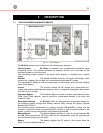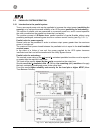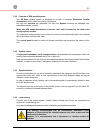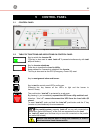
g
GE
OPM_SGS_USM_10K_40K_0US_V010.doc 14/88 Operating Manual
SG Series
10, 20, 30 & 40 kVA
3.3 PARALLEL SYSTEM OPERATION
3.3.1 Introduction to the parallel system
Two or more equal power units can be paralleled to increase the output power (paralleling for
capacity) or to improve the overall reliability of an UPS system (paralleling for redundancy).
The outputs of parallel units are connected to a common power bus, and in normal operation
the units connected on the parallel bus share the Load equally.
The modular concept of SG Series
allows parallel operation of
up to 8 units
, without using
paralleling switchgear, external bypass circuits or common control circuitry (see Fig. 3.3.1-1).
Parallel units for power capacity
Several units can be paralleled in order to achieve output power greater than the maximum
power of a single unit.
The maximum total power shared between the paralleled units is equal to the total installed
nominal power.
In the event of a failure of one unit, the power supplied by the UPS system becomes
insufficient and the Load will be transferred to the Utility Bypass source.
Parallel units for redundancy
The nominal power rating of the n+1
out of n redundant paralleled modules must be equal to
or greater than the required
Load
power.
The Load will be equally shared by the n
units connected on the output bus.
Should one of the n
paralleled units trip Off-line, the remaining (n+1) modules will supply
the load, maintaining conditioned power to the critical load.
From this results higher reliability and security for the Load plus a higher MTBF (Mean
Time Between Failures).
Fig. 3.3.1-1 Block diagram parallel system operation


















